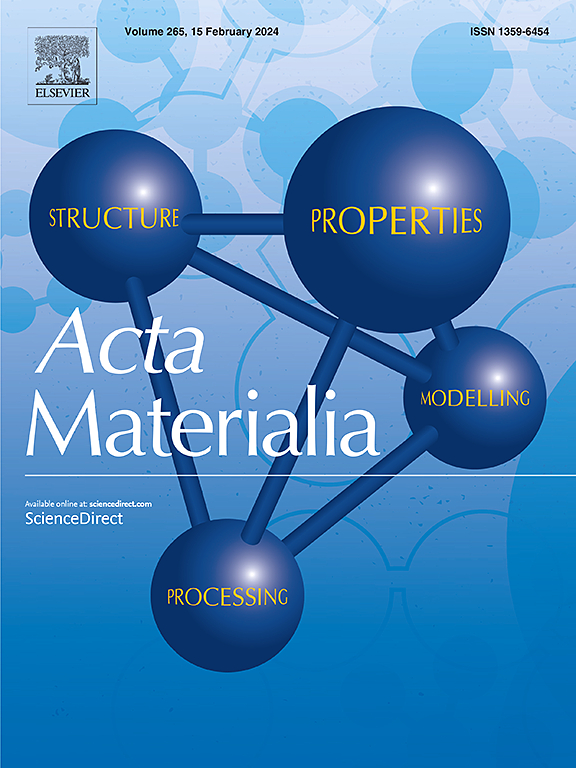新型掺锌纳米硅基玻璃陶瓷具有优异的锂电导率和增强的性能作为固体电解质
IF 9.3
1区 材料科学
Q1 MATERIALS SCIENCE, MULTIDISCIPLINARY
引用次数: 0
摘要
在各种各样的固体电解质选择中,微晶玻璃在全固态锂电池中应用前景广阔。在这方面,我们通过创新的方法有效地开发了新型玻璃和玻璃陶瓷,将玻璃陶瓷策略与新引入的锌掺杂Nasicon相结合。这是通过应用熔体淬火技术以及在结晶动力学的深入研究指导下对结晶过程的细致控制来实现的。结晶动力学揭示了二维成核机制,活化能为165 kJ.mol-1。x射线衍射(XRD)分析显示,在30li20 - 20zno - 20tio2 - 30p2o5玻璃陶瓷中出现了一种新的掺锌Nasicon相,鉴定为Li1.6Zn0.3Ti1.7(PO4)3,通过Rietveld细化证实了这一验证。事实上,FT-IR,拉曼和核磁共振分析证实了在玻璃陶瓷结构中Li1+2xZnxTi2-x(PO4)3 Nasicon相的形成。此外,SEM图像,加上TEM观察和密度评估,为创建具有条纹微观结构的致密,无孔玻璃陶瓷提供了证据。30li20 - 20zno - 20tio2 - 30p2o5玻璃陶瓷具有出色的化学耐久性和强大的机械性能。值得注意的是,它具有较高的总离子电导率,达到7.14.10-4 Ω-1。Cm-1室温下,电子导电性较低,为8.10-9 Ω-1。cm-1,与紫外可见光谱学的结果一致。此外,锂转移数确认为0.99,将开发的玻璃陶瓷定位为储能领域极具竞争力的固体电解质。对结晶Li1.6Zn0.3Ti1.7(PO4)3 NASICON相进行了DFT计算,以详细了解其热力学稳定性和电子性质。本文章由计算机程序翻译,如有差异,请以英文原文为准。

Novel Zn-doped Nasicon-based glass-ceramic with superior Li-conductivity and enhanced properties as a solid electrolyte
Among the diverse array of solid electrolyte options, glass-ceramics hold great promise for application in all-solid-state lithium batteries. In this respect, we have effectively developed novel glasses and glass-ceramics through an innovative approach that integrates a glass-ceramic strategy with the newly introduced zinc-doped Nasicon phase. This was achieved by applying melt-quenching techniques coupled with meticulous control over the crystallization process, guided by a thorough study of crystallization kinetics. The crystallization kinetics have unveiled a two-dimensional nucleation mechanism with an activation energy of 165 kJ.mol-1. X-ray diffraction (XRD) analysis revealed the emergence of a novel Zn-doped Nasicon phase, identified as Li1.6Zn0.3Ti1.7(PO4)3, within the 30Li2O-20ZnO-20TiO2-30P2O5 glass-ceramic, a validation corroborated through Rietveld refinement. Indeed, FT-IR, Raman, and NMR analyses confirmed the formation of Li1+2xZnxTi2-x(PO4)3 Nasicon phase within the glass-ceramics structures. Moreover, SEM images, complemented by TEM observations and density assessments, provide evidence for the creation of a dense, pore-free glass-ceramic with a striped microstructure. The 30Li2O-20ZnO-20TiO2-30P2O5 glass-ceramic demonstrates outstanding chemical durability and robust mechanical properties. Notably, it exhibits high total ionic conductivity, reaching 7.14.10-4 Ω-1.cm-1 at room temperature, while displaying low electronic conductivity of 8.10-9 Ω-1.cm-1, aligning with findings from UV-visible spectroscopy. Additionally, the lithium transference number is confirmed to be 0.99, positioning the developed glass-ceramic as a highly competitive solid electrolyte in the field of energy storage. DFT calculations were conducted on the crystallized Li1.6Zn0.3Ti1.7(PO4)3 NASICON phase to gain detailed insights into its thermodynamic stability and electronic properties.
求助全文
通过发布文献求助,成功后即可免费获取论文全文。
去求助
来源期刊

Acta Materialia
工程技术-材料科学:综合
CiteScore
16.10
自引率
8.50%
发文量
801
审稿时长
53 days
期刊介绍:
Acta Materialia serves as a platform for publishing full-length, original papers and commissioned overviews that contribute to a profound understanding of the correlation between the processing, structure, and properties of inorganic materials. The journal seeks papers with high impact potential or those that significantly propel the field forward. The scope includes the atomic and molecular arrangements, chemical and electronic structures, and microstructure of materials, focusing on their mechanical or functional behavior across all length scales, including nanostructures.
 求助内容:
求助内容: 应助结果提醒方式:
应助结果提醒方式:


